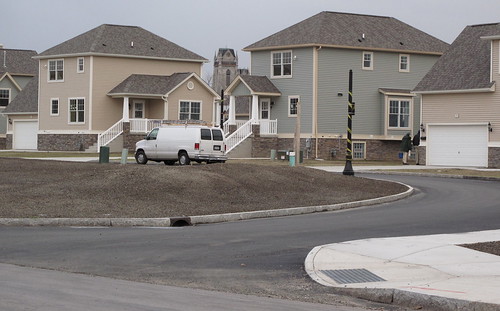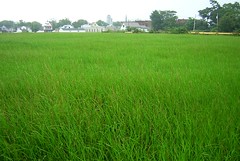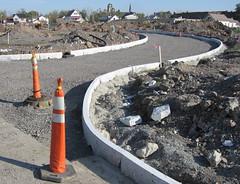I missed the opening. Nice garage!
Let me know what you think. Thanks.
__________________________________________________________________________While I'd never begrudge anyone an affordable, clean and decent place to live - sometimes you just got to wonder where the priorities are, or in this case, where they've been. The point is this. Closer to the downtown core along so many blocks between Genesee and Broadway and west of Jefferson, there are neighborhoods that were started years ago with some of the most amazing residential urban infill we have in the city. There are streets lined with modest brick duplexes and singles. Houses that fit the city and streetscape and routinely sell in the $60-80K range. Between many of these houses are gaps that need to be filled to create the sort of urban density that could potentially attract retail and commercial development. Simple.
Instead, City planners leap frogged that area and built houses that are ostensibly designed to lure suburban residents to the city and in this case, away from the core and away from downtown. While cool houses like this - corner of Monroe and Sycamore - were demolished to make room for the first phase of these heavily subsidized new builds, it will be interesting to track what the new residents are leaving behind when they move to Sycamore Village. Many veteran observers have told me that new builds along William and Clinton Streets are directly linked back to areas of the city like Hamlin Park - a game of musical chairs. No doubt an interesting trend, where one part of the city grows at the expense of another.
Same Spot - Three Years
2006 • 2007 • 2008
2006 • 2007 • 2008
The other long term issue that's looming has to do with environmental issues involving the site's remediation. For the first time I spent some time this afternoon in the Hickory Woods neighborhood, off Hopkins Street. In August I visited Love Canal. Twice in recent memory municipalities have pushed and marketed housing on contaminated sites. Any thoughts on what the story here at Sycamore Village might be in the years ahead?
The other issue is the immediate area's new build foreclosure history. I covered part of that disturbing trend here and here recently. New builds available for the second time around are selling for a fraction of their original sale price!
Lots of questions - why here, when the actual construction costs exceed $205,000/house - and no answers. Here's a flickr stream - Sycamore Village - with site construction pics.Let me know what you think. Thanks.
Artspace • BAVPA • Woodlawn Row Houses • fixBuffalo flickr
Creative Class • Shrinking Cities • Saturdays in the neighborhood






7 comments:
I know we always disagree on these, but I still like these and the development for the most part. Though that old brick house could have been (and should have been) saved and restored as part of the overall project.
These are some of the nicest planned and quality new builds since the Pratt homes down the street. If planned properly they can form a nice bookend to this replanting of the near east side. I think the close grouping (as opposed to scattering them amongst existing ones) will also help it in the long run. The empty Buffalo Forge site next door is ripe for phase two of these plus some smartly designed commercial along Broadway.
If they do pull from Hamlin, hopefully Hamlin fills in with others from other parts of the east side looking to "move up" but not being able to afford these type. People are still vacating the east side. Some more options in new build and nice kept old build, such as Hamlin, can be a plus to retain them.
As for the condition of the land, time will tell. I'm not sold on the central walkway either as opposed to central streets. That the majority of the houses on Sycamore have driveways at the rear alley is very nice. They should have included the plot at Mortimer and Matthew in the overall design. If the subsidizing pays off will depend on long range city planning and implimentation.
An St Ann's looks great in the one picture.
to be fair you should complain about the massively government subsidized suburban sprawl development as well.
Oh yes it is subsidized, just not so openly.
First buyers from Berkshire Ave?
I learned that the buyers profiled in the Sycamore Village press conference (Mr & Mrs Pheland Floyd) have apparently long lived on the 500 block of struggling Berkshire Ave in the fast-slipping 14215 zipcode.
Other recent sales nearby to the Floyds have been $13K (#455, 2/26/08), $33.5K (#512), $26K (#492), & $25K (#459).
Many buyers of previous heavily subsidized downtown newbuilds have also come from struggling city neighborhoods, speeding their decline . . . . at very heavy taxpayer cost.
SEE: BfloRising
http://buffalorising.com/story/first...e_villag_1#sca
First Phase of Sycamore Village Opens (Press Conference)
Dick Kern (in Mpls)
373 Sycamore Street was a beautiful interesting house. Why not renovate? Why not renovate the hundreds of savable empty houses? Old renovated homes retain value much more than these houses. If people wanted houses like these they would move to the suburbs. Put the money into what is already in the city or if you are going to build make it look like a city. Personally I would rather live in a 100 year old cottage house with real hardwood floors, a history, and some character.
Meg,
At the time I shot 373 Sycamore in June '05, at the corner of Mortimer, I had no idea that Sycamore Village was on the radar. Someone had recently replaced the roof and the structure seemed viable.
It's interesting that people refer to houses such as these as "suburban-style" and then say they belong only in the "suburbs"!!!
What these houses are is American Middle Class in style and classification and affordability.
Starting in the 1940's and onward, a new era was born!
When people came to America from foreign lands, they built according to what they left behind in their homelands. They did this building in the emerging cities. Then people filled up the cities (urban areas) and proceeded to sprawl out into the semi-urban (suburban) areas.
Once in America for several generations though, those different distinctions in tastes of residential structures melded together producing something the American middle class could afford.
The first such "suburban-style" houses had detached garages and were built on larger parcels of land.
That became too expensive for middle-class families so then along came the styles with attached garages (which even the upper middle-class appear to prefer today.)
Also, in the 1940's mortgages were secure. By the late 1960's it was necessary for lenders to devise "creative mortgaging" so that middle-class families could still manage to "afford" homeownership. Those creative notions kept being recreated on downward to the present house-financing mess.
The houses being built today in both city and suburbs are what middle-class families can still afford. (Low-income is a class below middle-class but above poverty, but, if a low-income family has a mortgage, that places them moreso in the lower middle-class of homeowners--yes, its complicated and mortgage lenders knew that!)
As far as how these homeowners, both city and suburbs, both then and now, got to be homeowners, "creative mortgages" are no different from government grants.
As far as where the homeowners lived before buying, many of them were renters and the houses they left were and still are owned by real estate "investors"!
And these re investors are infilterating everywhere now!
Or call me Crisa! How come the error name "Chrisa" went through but Crisa won't?
Post a Comment